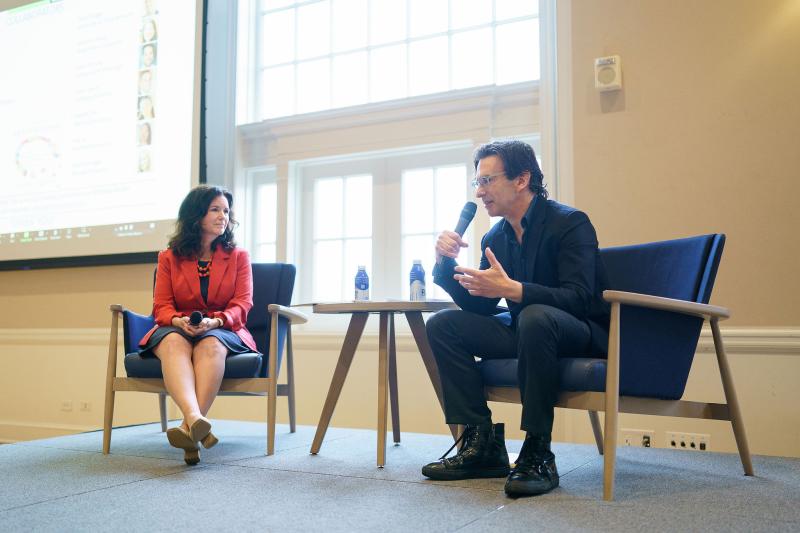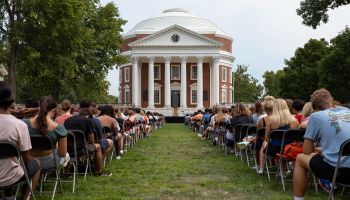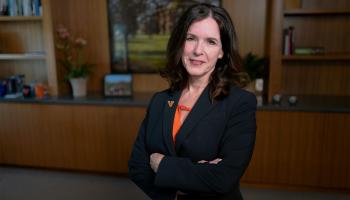Q&A: "How Can We Build a Sense of Belonging at UVA?"

The value of cultivating a sense of community and belonging — on college campuses, at work, at home and in our other communities — has emerged as an important area of research. Some of the top scholars and practitioners doing work in that growing field came to the University of Virginia on April 3 for “Inclusive Futures: Belonging in Higher Education and Beyond,” a one-day conference hosted by the University of Virginia. Among the conference highlights was a public conversation between Christa D. Acampora, UVA’s Buckner W. Clay Professor of Philosophy and Dean of the College and Graduate School of Arts & Sciences, and Stanford University social psychologist Geoffrey Cohen.
The author of Belonging: The Science of Creating Connection and Bridging Divides and Stanford’s James G. March Professor of Organizational Studies in Education and Business, Cohen discussed his work researching the importance of cultivating a sense of belonging in virtually every area of social life. Cohen introduced some of the concrete, science-based strategies he and other researchers have developed to create more welcoming environments and spaces for people from all walks of life before sitting down to chat with Acampora, who speaks frequently to UVA students and other audiences about the importance of cultivating a sense of community and belonging on Grounds.
(This conversation has been edited for clarity and length.)
CA: Thank you for such a rich presentation, Geoff. I wonder whether you might say a bit more about the fundamental idea: What does it mean to belong? Is it primarily a feeling? In order to belong, do you have to conform to the larger group — or are you saying something different?
GC: I think belonging can be seen both as a state, as in ‘I feel like I matter to this group, and the group matters to me.’ … In addition, it’s a process. It’s something that's never fully resolved. You're always working it out. … I think a lot of people end up taking belonging for granted, but then they really feel it, I think it's almost like a via negativa. You really fell it when all of a sudden, it's taken away. It’s like the rug is taken out from under your feet.
That's why I think these studies by Kip Williams and others where they exclude people in these online games where the test subjects are playing with a stranger, and they find that it undermines their sense of meaning. It registers in the brain as physical pain. That shows that what we really experience is this kind of feeling of exclusion, and we really understand or appreciate the importance of belonging when it's taken away.
One other thing: the research suggests that belonging comes from lived situations, experiences that people have, and if you're experiencing an institution that's actually proactively making efforts to include me, that's the best recipe for belonging.
CA: One thing that struck me about your book is that at every opportunity you point to research-based solutions, and often those solutions involve something you call “situation-crafting.” Tell us what you mean by that. What is “situation-crafting”? Are there other examples you’d like to share?
GC: I think that’s a common motif here, and one of the lifelong lessons that comes out of social psychology is that a lot of the visible behavior out there in the world comes not only from experiences and circumstances from right here, right now, but also experiences that were lived by someone in the past. For example, the feedback study that I mentioned, you could imagine being a teacher and giving feedback where only 17% of my students are revising their essay. What are you going to think? A lot of our biases tell us that, “Well it must be something about the kids’ grit or wit or values.”
And all of those explanations would miss the mark, which is, no, it's actually something about the way in which I'm giving feedback, the situation that I'm creating for these students that is at work or at play here. I'm in a position to influence, so situations are a kind of a lever for change. We're always part of a situation. It’s kind of interesting: what is the situation? How can I influence it? We often underestimate our role, our power as agents of the situation as teachers and also as friends.
Even in interactions out there in the world with other people, we underestimate how much power we have to create connection and bridge divides through the feedback we get, the kinds of questions we ask people. The interesting curiosity we have in other people's perspective, all of these things are subtle ways in which we can alter situations so that other people feel more seen, more appreciated. That’s one of the key lessons here: the power of situations which are in our ability to control, which paradoxically means the individual’s powerful, but the power comes from this indirectly, from changes we can make in the situation. That’s such a such a powerful lesson: the importance of circumstances and our ability to influence them every day, and I think there's given the research, I kind of look at those control groups as indicators of missed opportunities … It seems like we miss a lot of opportunities to change situations for the better.
CA: Something I’ve observed at UVA is that the place is often animated by an inclination toward creating special opportunities to come together, to gather. As I’ve observed and tried to understand this, it seems to me to have at least two characteristics: a spirit of playfulness and creativity, and a powerful sense of love and belief in one another's humanity. I have said to other university leaders that before coming to UVA, I had not encountered a community that so often and openly expressed itself in terms of love. There is potentially a lot of power in that. I know you’ve thought a lot about this, too. Could you say a few things about how you think about belonging and love?
GC: It reminds me a little bit of an essay by a former student who died in a car accident, … She was talking about her experience in college and what was so special about it, and she wrote something like this: “There needs to be a word, it's like the opposite of ‘lonely.’” She was kind of grasping at it, and I think she does say, “it's a little like love, but maybe not quite love, but it's that feeling of abundance that you have people in your corner and you're not alone.”
And I think that's what you're getting at here. The more of those opportunities that we can create on campuses, that feeling of abundance where we're in this together the more that feeling of “us” comes fruition.
It sounds like here at UVA you’re doing a lot of things like that. And it’s really not to be underestimated in its impact. Just to build on that with one example from the research, a lot of the research on bridging divides and overcoming prejudice shows two things. One is that information campaigns and persuasion, to help people be less biased and more charitable with other people, those things don't work.
What does work is changing behavior. Get people to act in a charitable way across lines of difference, and their hearts and minds follow. Love follows. In some traditions, the word love comes from the word “to give.” If I'm giving to others, I start to love more. And so, these opportunities, especially, for instance, volunteer activities and purpose-driven clubs getting people to cooperate together in pursuit of a higher purpose — what social psychologists call superordinate goals — is one of the best ways to kind of create that spirit of love. Bring people together even across lines of difference, and I would say that’s one of the top lessons in social psychology.
CA: A big topic now: how can belonging help us with talking with others across political divisions? In your book, you cite evidence about how belonging is important for democracy — not what we believe, or the substance of our agreements and disagreements, but instead how we pursue democratic processes in thinking through issues together. Could you share some ideas about how a focus on belonging might be important for bringing democratic values into our day-to-day encounters?
GC: One way to look at this is that there's a kind of manifest task we all have, the task that's on the surface. We're just learning, we’re educating … we're just having a conversation. I'm trying to discuss some political topic, for instance. That's the kind of manifest task, but then underneath, there's a kind of latent task, and that latent task is, “Will I be seen in a respectful way here, or will I be diminished in some way, maybe based on my identity? Am I being seen with dignity or not?” That's the kind of underground task that we have, and if you address the latent task, then people can focus on the manifest task.
I think a lot of the activities and approaches that I presented kind of do that. They address that latent task so that the students are better able to focus on the manifest task, learn and take advantage of critical feedback. It could be experiences even in relationships where “I’m feeling really insecure here it's just hard for me to enjoy the situation. It’s hard for me to trust.”
In terms of politics, I think it’s the same thing. Kurt Lewin was really interested in the idea that democracies live down on the ground in our interactions. It's not just a value. It's behavior, and in some research … it’s a way of enacting democracy so that the latent task is sort of addressed and satisfied. And what these researchers do, to make a long story short, is to bring people together across political lines — Republicans and Democrats, people who just differ on important, controversial topics like the war in the Middle East. You bring them together to discuss it, and they do three things: one, in just a 10-minute activity, they cultivate what's called a “respect mindset.” They teach people that one of the worst things you can do is make the other person feel disrespected.
When you do that, people shut down. They feel threatened. They go into a fight-or-flight response, and no information you could try to convey is going to get through to them. Better to make them feel respected in spite of the disagreement, and that opens their mind.
It’s very important. People learn better when they're respected, or they feel respected. And then we teach them two strategies, ways to enact democracy in the moment. They’re beautifully simple, but I think hard to do. One is what has been called “charitable reflection,” where I just make sure I heard you right: “So, you're saying you have Position X because of your values X, Y and Z.” So, I reflect back to make sure I understand what you said. We're just drawing this from other research. That's it. Then I correct course if I misunderstood.
And then the second thing we do is to teach them to do one thing when they give their opinion. And that is, before they give their opinion, to say, “I think,” or maybe some other subjective caveats like “from my perspective.” But frame your points of view as opinions rather than statements of fact. And these strategies do two things. One, they help people come across better, but they also change the person themselves so that they start to see themselves as more open-minded and more tolerant. And what we find is that improves their persuasiveness. It reduces people's own tendency to think that their positions are objective, which is a real toxin today.
It’s been called the “objectivity illusion,” the belief that “I see the world as it is.” It turns out that objectivity illusion is predictive of bias: the more people think they're objective, the more biased they actually are. So, it helps to overcome that, and it makes the conversations just go a lot a lot better. Though it seems obvious, it turns out most people in the control group don't do these things, but it only takes a little bit to encourage them to do it, with some powerful ripple effects.
CA: Before opening it up for other questions, I’d like to focus on leadership. How can organizations such as schools and universities — and their leaders—mobilize to incorporate these ideas you’ve studied about the power of the situation? How can we go beyond the one-off interventions you've talked about to introduce more systemic changes in our institutions? Could you share an example of a success story?
GC: Three things: one is what's called in the literature “transformational leadership,” where you're leading with vision. You talk the talk, but you also walk the walk. You say, “II have this commitment to diversity and to diversifying the institution. That's our value. That's my value.” So, evoking common purpose and then trying to make real change to realize those values.
The second thing is what's known as “perspective getting.” Getting people's perspectives rather than assuming them. I think all of us do this. We too readily assume we know what's bugging people, what their barriers are. When what we should really do is take the time to ask them. “Tell me about the circumstance you're in. What's your situation like? What's it like to be here at this place or work here in this office? I'd love to learn more. … What can we do to make it better?”
I’m going to call out really quick one of my favorite recent studies by two economists who use perspective getting to create an intervention for first-generation students. They just interviewed first-generation students in college and asked them, ‘Hey, what can we do to make your experience better?” The students said two things: “We want more faculty engagement, and we want more tips on how to get better.”
Then the intervention just addressed those needs. The instructor sent two emails to students at the beginning of an introductory course that gave them tips on how to improve and to remind the students of their office hours, and they had these humongous effects.
Usually when you have an intervention, there’s an effect on GPA of about 0.2 GPA points, which is pretty good if you can do that over and over again. In their study, they found an effect for first-gen students of 1.0 GPA points. Just. Ask. That's another aspect of leadership: asking good questions and listening to the answers. It sounds simple. Beautifully simple, hard to do.
And then number three is empowering people. A lot of these interventions that have been very successful put students in positions of empowerment. “We want to know from you how to make the school better, and we're going to provide you with resources to do it.”
Some research by Elizabeth Paluck at Princeton University has done this with public schools, and then actually at Wooster College after a visit there, they implemented a course on belonging for undergraduate students where they introduced them to the research on belonging and then mobilized them together to create little breakfast clubs at their school to make the campus life better. … The idea is you empower students with democratic adult leadership to identify the changes that the students want to make and give them the resources to make that change on their campus. Those three things — transformational leadership, i.e. talking the talk but walking the walk; perspective getting, asking good questions and listening to the answers; and empowering people to make the changes that they want.






